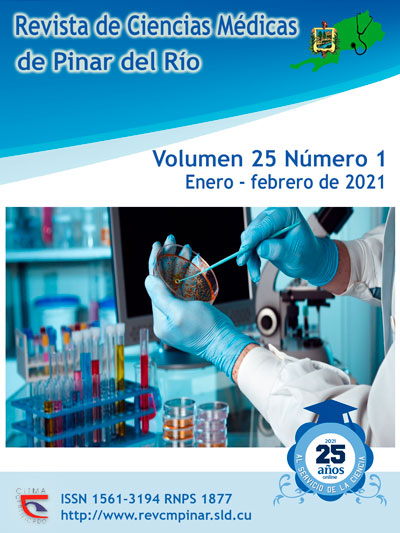Coexistence of facial dysmorphia and congenital malformations in human fetuses
Keywords:
HEART DISEASES, CONGENITAL ABNORMALITIES, FETUS, MICROGNATHISM, RETROGNATHIA.Abstract
Introduction: facial dysmorphia is a topic approached from multiple angles. The coexistence of these and other disorders of the human body can be explained by the processes that occur during the development of the embryo.
Objective: to determine the relationship between facial dysmorphia and congenital malformations present in the system of organs in human fetuses.
Methods: an analytical, cross-sectional, observational research was carried out on 42 human fetuses resulting from pregnancy interruptions. During the autopsy, facial structures were measured. Facial profile, symmetry, existence of facial hypoplasias and congenital malformations in different system of organs were considered.
Results: 66,7 % of male fetuses were observed, average maternal age was 29,3 ± 7,5 years. Dysmorphia of the facial profile (73,8 %), the frontal region (57,1 %) and the jaw (54,7 %) were more frequent. Only cardiovascular malformations showed a positive, significant correlation with signs of facial dysmorphia (p=0,006; R=0,414).
Conclusions: facial dysmorphia in human fetuses was related to malformations of the cardiovascular system, which could be useful in the early diagnosis of congenital heart defects.
Downloads
References
1. Yadav S, Malla B, Srivastava A. Anthropometric Study of Philtrum (Face) and other nasal parameters in Nepal. Int. J. Mod. Anthrop.[Internet]. 2018 [citado 30/06/2020]; 2(11): p. 163-180. Disponible en: https://www.ajol.info/index.php/ijma/article/view/177213
2. Ornoy A. Craniofacial malformations and their association with brain development: the importance of a multidisciplinary approach for treatment. Odontology. [Internet]. 2020 Jan[ citado 30/06/2020]; 108(1): p. 1-15. Disponible en: https://pubmed.ncbi.nlm.nih.gov/31172336/
3. GOLDSTEIN I, TAMIR A, WEINER Z, JAKOBI P. Dimensions of the fetal facial profile i n normal pregnancy. Ultrasound Obstet Gynecol. [Internet]. 2010 [citado 30/06/2020]; 35: p. 191–194. Disponible en: https://obgyn.onlinelibrary.wiley.com/doi/pdf/10.1002/uog.7441
4. Côrte Real I, Braga A, Nogueira R, Felino A, Valente F, Vaz P. Growth pattern of the philtrum in cases of normal and pathological fetal development. Rev Port Estomatologia, Medicina Dentária e Cirurgia Maxilofacial [Internet]. 2016[ citado 30/06/2020]; 57(4): p. 223–228. Disponible en: https://www.elsevier.es/en-revista-revista-portuguesa-estomatologia-medicina-dentaria-330-articulo-growth-pattern-philtrum-in-cases-S164628901630036X
5. González Espangler L. Modelo cefalométrico predictivo para el brote de los terceros molares. Tesis de doctorado.. Universidad De Ciencias Médicas De Santiago De Cuba, Departamento De Ortodoncia.2019. Disponible en: http://tesis.sld.cu/index.php?P=FullRecord&ID=713
6. Estrada Padilla SA, Corona Rivera JR, Sánchez Zubieta F, Bobadilla Morales L, Corona Rivera A. Variantes fenotípicas menores en pacientes con leucemia linfoblástica aguda del occidente de México. An Pediatr. [Internet]. 2015 [citado 30/06/2020]; 82(2): p. 75-82. Disponible en: https://www.sciencedirect.com/science/article/pii/S1695403313004967
7. Mohlina S, Kunttas E, Persson C. Maintaining multipotent trunk neural crest stem cells as self-renewing crestospheres. Developmental Biology.[Internet]. 2019 Mar[citado 30/06/2020]; 447: p. 137–146. Disponible en: https://pubmed.ncbi.nlm.nih.gov/30664880/
8. Vandamme N, Berx G. From neural crest cells to melanocytes: cellular plasticity during development and beyond. Cell Mol Life Sci. [Internet]. 2019 May [citado 30/06/2020]; 76(10): p. 1919–1934. Disponible en: https://pubmed.ncbi.nlm.nih.gov/30830237/
9. Giniunaite R, Baker R, Kulesa P, Maini P. Modelling collective c ell migration: n eural c rest as a model paradigm. Journal of Mathematical Biology. [Internet]. 2019 [citado 30/06/2020]; 80: p. 481–504. Disponible en: https://link.springer.com/article/10.1007/s00285-019-01436-2
10. Nakayama N, Pothiawala A, Lee J. Human pluripotent stem cell derived chondroprogenitors for cartilage tissue engineering. Cell Mol Life Sci. [Internet]. 2020 Jul[ citado 30/06/2020];77(13): p. 2543-2563. Disponible en: https://pubmed.ncbi.nlm.nih.gov/31915836/
11. Arai H, Sato F. Metalloprotease-Dependent Attenuation of BMP Signaling Restricts Cardiac Neural Crest Cell Fate. Cell Rep. [Internet]. 2019 [citado 30/06/2020]; 29(3): p. 603–616. Disponible en: https://pubmed.ncbi.nlm.nih.gov/31618630/.
12. Etchevers H, Dupin E, Le Douarin N. The importance and impact of discoveries about neural crest fates. Cornell University [Internet]. 2018 [citado 30/06/2020];: p. Disponible en: https://arxiv.org/abs/1808.00204
13. Tang W, Martik M, Li Y, Bronner M. Cardiac neural crest contributes to cardiomyocytes in amniotes and heart regeneration in zebrafish. eLife. [ Internet]. 2019 [citado 30 jun 2020]; 8: p. Disponible en: https://www.ncbi.nlm.nih.gov/pmc/articles/PMC6721792/
14. Firulli B, Firulli A. Partially Penetrant Cardiac Neural Crest Defects in Hand1 Phosphomutant Mice: Dimer Choice That Is Not So Critical. Pediatric Cardiology. [Internet]. 2019 [citado 30/06/2020]; 40(7): p. 1339–1344. Disponible en: https://pubmed.ncbi.nlm.nih.gov/31338559/
15. Chacon J, Rogers C. Early expression of Tubulin Beta-III in avian cranial neural crest cells. Gene Expression Patterns. [Internet]. 2019 [citado 30/06/2020]; 34: p. Disponible en: https://www.sciencedirect.com/science/article/pii/S1567133X19300675
Downloads
Published
How to Cite
Issue
Section
License
Authors who have publications with this journal agree to the following terms: Authors will retain their copyrights and grant the journal the right of first publication of their work, which will be publication of their work, which will be simultaneously subject to the Creative Commons Attribution License (CC-BY-NC 4.0) that allows third parties to share the work as long as its author and first publication in this journal are indicated.
Authors may adopt other non-exclusive license agreements for distribution of the published version of the work (e.g.: deposit it in an institutional telematic archive or publish it in a volume). Likewise, and according to the recommendations of the Medical Sciences Editorial (ECIMED), authors must declare in each article their contribution according to the CRediT taxonomy (contributor roles). This taxonomy includes 14 roles, which can be used to represent the tasks typically performed by contributors in scientific academic production. It should be consulted in monograph) whenever initial publication in this journal is indicated. Authors are allowed and encouraged to disseminate their work through the Internet (e.g., in institutional telematic archives or on their web page) before and during the submission process, which may produce interesting exchanges and increase citations of the published work. (See The effect of open access). https://casrai.org/credit/



